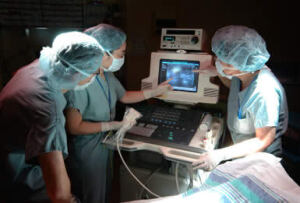A maker of point-of-care ultrasound devices has released two new studies saying bedside ultrasound scans cut the risks of expensive complications for two needle-based procedures.
SonoSite Inc., based in Bothell, Wash., delivered the results at a National Patient Safety Foundation's 2011 congress in Washington, D.C. this week.
The company says, in two observational cohort studies, it found using ultrasound to guide the two procedures helped lower risks of complications. For example, when sampling fluid around the lungs, ultrasound helps reduce the risk of a collapsed lung by as much as 19 percent, according to SonoSite.



Ad Statistics
Times Displayed: 77573
Times Visited: 2712 Ampronix, a Top Master Distributor for Sony Medical, provides Sales, Service & Exchanges for Sony Surgical Displays, Printers, & More. Rely on Us for Expert Support Tailored to Your Needs. Email info@ampronix.com or Call 949-273-8000 for Premier Pricing.
"[T]his new evidence marks the beginning of a significant body of work pointing to cost and safety gains in acute care settings," Dr. Diku Mandavia, SonoSite's chief medical officer and a study co-author, said in a statement.
The two procedures studied include thoracentesis, which involves removing fluid from the space outside the lungs, and paracentesis, which involves removing fluid from the belly.
Complications from thoracentesis include collapsed lung (pneumothorax), and for paracentesis excessive bleeding. They can both increase the length of hospital stays and add thousands of dollars to a patient's bill, SonoSite said.
Both studies relied on Premier Perspective automated hospital database, with data from 2007 to 2008, and were conducted with researchers from United BioSource Corporation, a life sciences consulting group.
In the thoracentesis study, the researchers looked at records from 61,261 patients. Of these, 26,838 (44 percent) had ultrasound guidance, and 34,423 (56 percent) did not, according to the abstract posted on SonoSite's website. Patients were considered to have had ultrasound guidance if they were billed for ultrasound on the same day as their thoracentesis procedure.
For patients with ultrasound guidance, the risk of pneumothorax was 2.45 percent; for those believed not to have had ultrasound guidance, the risk was 3.02 percent.
Complications from the procedure significantly increased the cost and length of stay, the researchers found. According to SonoSite's analysis, complications increased hospitalization costs from $11,032 to $13,784, and increased the average length of stay from 6.5 days to 7.9 days.
Findings were similar for paracentesis. The study looked at 69,859 patients who underwent paracentesis; 31,649 (45 percent) had ultrasound guidance, and 38,210 (55 percent) did not. As with the thoracentesis study, ultrasound guidance was determined by patients having a scan the same day as their procedure.
For patients with ultrasound guidance, the risk of bleeding complications (hemorrhage, hematoma and hemoperitoneum) was 0.38 percent. For patients without ultrasound guidance, the risk was 1.25 percent.
As with thoracentesis, complications increased the length of stay and its costs. For patients with complications, hospitalization costs rose from $9,476 to $29,729. And the average length of stay nearly doubled, rising from 5.2 days to 9.5 days.
The National Patient Safety Foundation patient safety congress runs May 25-27.

